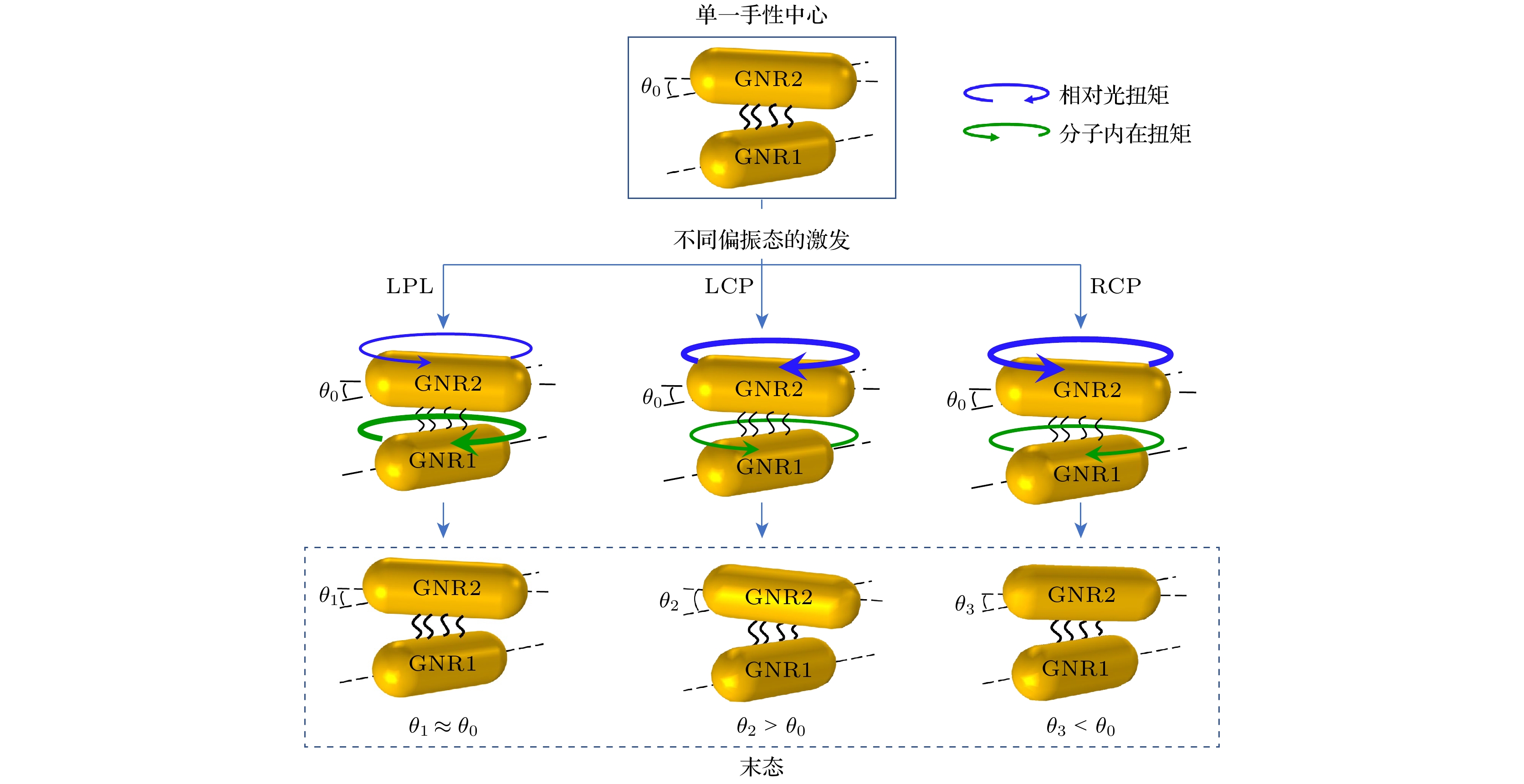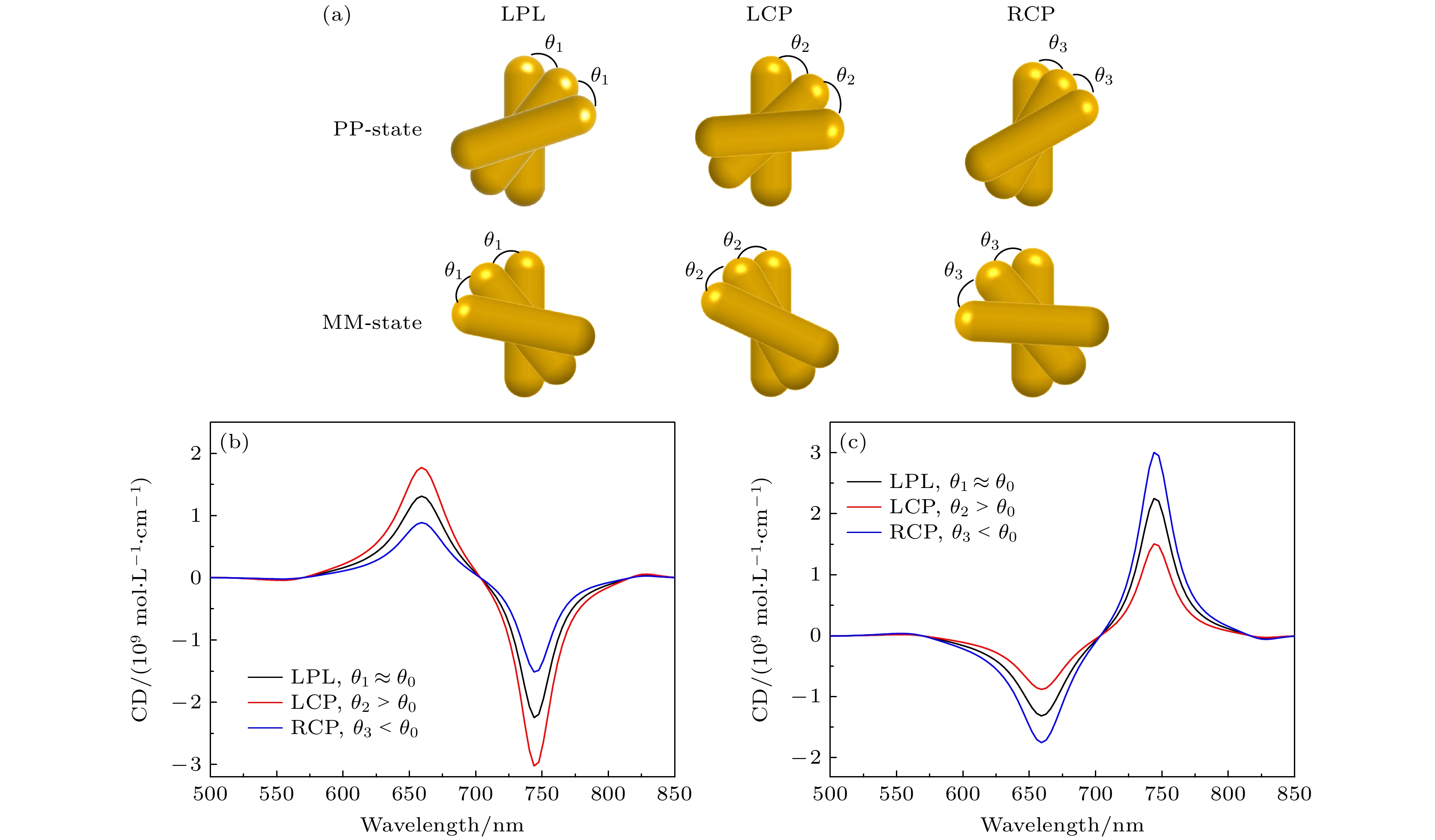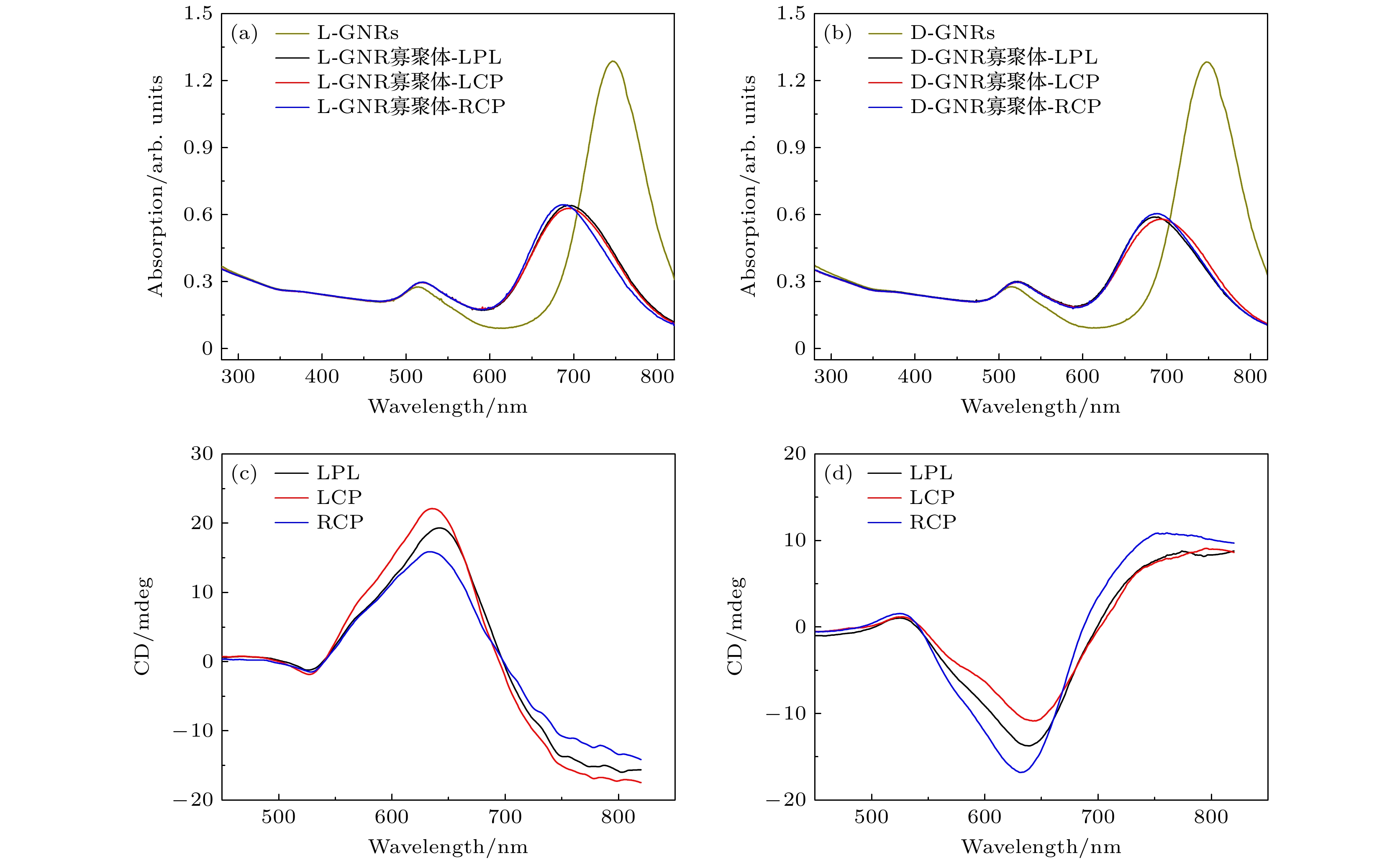-
光与金属纳米手性结构作用可展现超强的等离激元圆二色性. 然而, 光激发下金属纳米手性结构的光力与光热的协同作用效应如何影响其圆二色性, 仍缺乏深入的理解. 本研究针对具有相邻同手性中心的金纳米棒三聚体, 探讨了圆偏振光激发下的不对称光力与光热的协同作用效应对其手性结构及相应等离激元圆二色性质的影响. 基于有限元法的模拟计算表明: 在光热温度梯度场激活金纳米棒手性三聚体的结构动态变化的同时, 左旋/右旋圆偏振光产生的不对称光扭矩将导致金纳米棒三聚体几何结构(特别是手性中心的扭转角)出现不对称变化, 从而使金纳米棒三聚体的等离激元圆二色光谱响应呈现明显的偏振依赖性. 进一步的实验研究表明: 基于这种不对称光力与光热的协同作用效应, 左旋和右旋圆偏振光能够用于调控等离激元圆二色光谱响应的不对称增强和抑制. 本研究不仅为研究光学调控纳米等离激元手性组装结构奠定了理论基础, 也为实验设计和制备物理方法调控的先进纳米光子学器件提供了重要参考.Nano-plasmonic chiral structures exhibit stronger plasmonic circular dichroism than most organic materials. In addition to the circular dichroism response, the interaction between light and nano-plasmonic chiral structure also involves the photothermal and optomechanical effects. However, the synergy between the photothermal and optomechanical effects under circularly polarized light excitation remains poorly understood. This work investigates the synergy of the photothermal and optomechanical effects in chiral gold nanorod trimers. The asymmetric photothermal and optomechanical effects in gold nanorod trimers with adjacent homochiral centers are analyzed by finite element simulation. The simulation results show that the dynamic structure of the chiral gold nanorod trimer is activated when the photothermal temperature reaches the threshold value. At the same time, the asymmetric optical torque generated by left- and right-handed circularly polarized light will lead to asymmetric changes in the geometry of the gold nanorod trimer, especially in the twist angle of the chiral center, so that the spectral response of the gold nanorod trimer is polarization-dependent. More significantly, based on the synergy of the photothermal and optomechanical effects, experimental results show that the chiral gold nanorod oligomers can be used to control the asymmetric enhancement and suppression of the plasmonic circular dichroic spectral response through the enantioselective interaction of left- and right-handed circularly polarized light. This study provides an important reference for designing advanced nano-photonics devices.
-
Keywords:
- nano-plasmonic chirality /
- circular dichroism /
- asymmetric optomechanical effect /
- asymmetric photothermal effect
[1] Gerlach H 2013 Chirality 25 684
 Google Scholar
Google Scholar
[2] Morrow S M, Bissette A J, Fletcher S P 2017 Nat. Nanotechnol. 12 410
 Google Scholar
Google Scholar
[3] Hentschel M, Schäferling M, Duan X, Giessen H, Liu N 2017 Sci. Adv. 3 e1602735
 Google Scholar
Google Scholar
[4] Ma W, Xu L, de Moura A F, Wu X, Kuang H, Xu C, Kotov N A 2017 Chem. Rev. 117 8041
 Google Scholar
Google Scholar
[5] Ben-Moshe A, Maoz B M, Govorov A O, Markovich G 2013 Chem. Soc. Rev. 42 7028
 Google Scholar
Google Scholar
[6] Valev V K, Baumberg J J, Sibilia C, Verbiest T 2013 Adv. Mater. 25 2517
 Google Scholar
Google Scholar
[7] Soukoulis C M, Wegener M 2011 Nat. Photonics 5 523
 Google Scholar
Google Scholar
[8] McPeak K M, van Engers C D, Bianchi S, Rossinelli A, Poulikakos L V, Bernard L, Herrmann S, Kim D K, Burger S, Blome M, Jayanti S V, Norris D J 2015 Adv. Mater. 27 6244
 Google Scholar
Google Scholar
[9] Gansel J K, Thiel M, Rill M S, Decker M, Bade K, Saile V, von Freymann G, Linden S, Wegener M 2009 Science 325 1513
 Google Scholar
Google Scholar
[10] Hendry E, Carpy T, Johnston J, Popland M, Mikhaylovskiy R V, Lapthorn A J, Kelly S M, Barron L D, Gadegaard N, Kadodwala M 2010 Nat. Nanotechnol. 5 783
 Google Scholar
Google Scholar
[11] Ma W, Xu L, Wang L, Xu C, Kuang H 2019 Adv. Funct. Mater. 29 1805512
 Google Scholar
Google Scholar
[12] Solomon M L, Saleh A A E, Poulikakos L V, Abendroth J M, Tadesse L F, Dionne J A 2020 Acc. Chem. Res. 53 588
 Google Scholar
Google Scholar
[13] Hao C, Xu L, Ma W, Wu X, Wang L, Kuang H, Xu C 2015 Adv. Funct. Mater. 25 5816
 Google Scholar
Google Scholar
[14] Zheng J, Cheng X, Zhang H, Bai X, Ai R, Shao L, Wang J 2021 Chem. Rev. 121 13342
 Google Scholar
Google Scholar
[15] Chen H, Shao L, Li Q, Wang J 2013 Chem. Soc. Rev. 42 2679
 Google Scholar
Google Scholar
[16] Hu Z, Meng D, Lin F, Zhu X, Fang Z, Wu X 2019 Adv. Opt. Mater. 7 1801590
 Google Scholar
Google Scholar
[17] Nguyen M K, Kuzyk A 2019 ACS Nano 13 13615
 Google Scholar
Google Scholar
[18] Wang M, Dong J, Zhou C, Xie H, Ni W, Wang S, Jin H, Wang Q 2019 ACS Nano 13 13702
 Google Scholar
Google Scholar
[19] Pratap D, Shah R K, Khandekar S 2022 Appl. Nanosci. 12 2045
 Google Scholar
Google Scholar
[20] Baffou G, Girard C, Quidant R 2010 Phys. Rev. Lett. 104 136805
 Google Scholar
Google Scholar
[21] Huang W H, Li S F, Xu H T, Xiang Z X, Long Y B, Deng H D 2018 Opt. Express 26 6202
 Google Scholar
Google Scholar
[22] Zhang Q, Xiao J J, Zhang X M, Yao Y 2013 Opt. Commun. 301 121
[23] Avalos-Ovando O, Besteiro L V, Movsesyan A, Markovich G, Liedl T, Martens K, Wang Z, Correa-Duarte M A, Govorov A O 2021 Nano Lett. 21 7298
 Google Scholar
Google Scholar
[24] Zhao W, Zhang W, Wang R Y, Ji Y, Wu X, Zhang X 2019 Adv. Funct. Mater. 29 1900587
 Google Scholar
Google Scholar
[25] Song J, Ji C Y, Ma X, Li J, Zhao W, Wang R Y 2024 J. Phys. Chem. Lett. 15 975
 Google Scholar
Google Scholar
[26] Johnson P B, Christy R W 1972 Phys. Rev. B 6 4370
 Google Scholar
Google Scholar
[27] Song M, Tong L, Liu S, Zhang Y, Dong J, Ji Y, Guo Y, Wu X, Zhang X, Wang R Y 2021 ACS Nano 15 5715
 Google Scholar
Google Scholar
[28] Ma W, Kuang H, Xu L, Ding L, Xu C, Wang L, Kotov N A 2013 Nat. Commun. 4 2689
 Google Scholar
Google Scholar
[29] Wang S, Liu X, Mourdikoudis S, Chen J, Fu W, Sofer Z, Zhang Y, Zhang S, Zheng G 2022 ACS Nano 16 19789
 Google Scholar
Google Scholar
[30] Tan L, Fu W, Gao Q, Wang P P 2024 Adv. Mater. 36 2309033
 Google Scholar
Google Scholar
[31] Kim R M, Huh J H, Yoo S, Kim T G, Kim C, Kim H, Han J H, Cho N H, Lim Y C, Im S W, Im E, Jeong J R, Lee M H, Yoon T Y, Lee H Y, Park Q H, Lee S, Nam K T 2022 Nature 612 470
 Google Scholar
Google Scholar
-
图 1 GNR手性三聚体的物理模型及其光学性质 (a) 圆偏振光与GNR手性三聚体相互作用的物理模型, 展示了在六个方向平均的圆偏振光激发下的三聚体结构, 其中链接分子位于GNR之间的间隙区域; (b) PP型和MM型GNR手性三聚体的结构示意图; (c) PP型GNR三聚体的消光光谱; (d) 具有相反手性的GNR三聚体的等离激元CD光谱. 其中PP型GNR三聚体中GNR1-2和GNR2-3的扭转角$\theta = - 1.5^\circ $, MM型GNR三聚体中GNR1-2和GNR2-3的扭转角$\theta = 1.5^\circ $. 入射光功率密度为$ I = 1.4 \times {10^8}\;{\mathrm{mW}}{ \cdot}{\mathrm{ c{m}}^{ - 2}} $
Fig. 1. Physical models and optical properties of GNR chiral trimer: (a) The physical model of the interaction between circularly polarized light and GNR chiral trimer shows the trimer structure under six directions of average circularly polarized light excitation, with linking molecules located in the gap region between GNR; (b) the schematic diagram of the structure of PP-state and MM-state GNR chiral trimers; (c) the extinction spectra of PP-state GNR trimer; (d) the plasmonic CD spectra of GNR trimer with opposite chirality. The twist angle θ of GNR1-2 and GNR2-3 in PP-state GNR trimer is –1.5°, and the twist angle θ of GNR1-2 and GNR2-3 in MM-state GNR trimer is 1.5°. The incident light power density is $ I = 1.4 \times {10^8}\;{\mathrm{mW}}{ \cdot }{\mathrm{c{m}}^{ - 2}} $.
图 2 GNR1-2的光热CD (${\text{C}}{{\text{D}}_{\Delta {T_{{\text{{{rise}}}}}}}}$)、光热温度(${T_{{\text{{{rise}}}}}}$)和光扭矩($\Delta {{\boldsymbol{M}}_{Z21}}$) (a) GNR1-2间隙中心位置处的光热CD光谱. 插图为PP型GNR三聚体, 圆点标注了链接分子与GNR间隙区域的中心位置. 激光功率密度为$ I = 1.4 \times {10^8}{\mathrm{mW}}{ \cdot }{\mathrm{c{m}}^{ - 2}} $; (b)不同激光功率密度下PP型GNR三聚体中GNR1-2在间隙中心位置的光热温度; (c)不同偏振态的激光激发下, 扭转角$ {\theta _0} $在$ 0^\circ < $$ \left| {{\theta _0}} \right| < 5^\circ $范围内的GNR2相对于GNR1的光扭矩. 激光波长为721 nm, 功率密度$ I = 1.46 \times {10^8}\;{\mathrm{mW}}{ \cdot }{\mathrm{c{m}}^{ - 2}} $
Fig. 2. The photothermal CD (${\text{C}}{{\text{D}}_{\Delta {T_{{\text{rise}}}}}}$), photothermal temperature (${T_{{\text{rise}}}}$), and optical torque ($\Delta {{\boldsymbol{M}}_{Z21}}$) of GNR1-2. (a) The photothermal CD spectra at the center position of the GNR1-2 gap. The illustration shows a PP-state GNR trimer, with dots indicating the center position of the gap region between the linking molecule and GNR. The laser power density $ I = 1.4 \times $$ {10^8}\;{\mathrm{mW}}{ \cdot} {\mathrm{c{m}}^{ - 2}} $. (b) The photothermal temperature of GNR2-3 at the center of the gap in PP-state GNR trimer under different laser power densities. (c) Under laser excitation of different polarization states, the optical torque of GNR2 relative to GNR1 with a twist angle $ {\theta _0} $ in the range of $ 0^\circ < \left| {{\theta _0}} \right| < 5^\circ $. The laser wavelength is 721 nm, power density $ I = 1.46 \times {10^8}\;{\mathrm{mW}} {\cdot }{\mathrm{c{m}}^{ - 2}} $.
图 4 不同偏振态的激光激发下的GNR手性三聚体的末态及其模拟CD光谱 (a) GNR手性三聚体的结构变化的末态; (b) PP型GNR三聚体的模拟CD光谱; (c) MM型GNR三聚体的模拟CD光谱. 其中激光波长为721 nm, 功率密度$ I = 1.4 \times {10^8}\;{\mathrm{mW}}{ \cdot} {\mathrm{c{m}}^{ - 2}} $. 对于PP型GNR三聚体, θ0和θ1为–1.5°, θ2 = –2°, θ3 = –1°; 对于MM型GNR三聚体, θ0和θ1为1.5°, θ2 = 1°, θ3 = 2°
Fig. 4. The final state and simulated CD spectra of GNR chiral trimer under laser excitation of different polarization states: (a) The final state of GNR chiral trimer after structural change; (b) simulated CD spectra of PP-state GNR trimers; (c) simulated CD spectra of MM-state GNR trimers. The laser wavelength is 721 nm, power density $ I = 1.4 \times {10^8}\;{\mathrm{mW}}{ \cdot} {\mathrm{c{m}}^{ - 2}} $. For PP-state GNR trimer, θ0 and θ1 are –1.5°, θ2 = –2°, and θ3 = –1°; for MM-state GNR trimer, θ0 and θ1 are 1.5°, θ2 = 1°, and θ3 = 2°.
图 5 不同偏振态的激光激发下GNR手性寡聚体的吸收光谱与等离激元CD光谱 (a) L-GNR寡聚体的吸收光谱; (b) D-GNR寡聚体的吸收光谱; (c) L-GNR寡聚体的等离激元CD光谱; (d) D-GNR寡聚体的等离激元CD光谱. 其中激光波长为721 nm
Fig. 5. Absorption spectra and plasmonic CD spectra of GNR chiral oligomers under laser excitation of different polarization states: (a) The absorption spectra of L-GNR oligomers; (b) the absorption spectra of D-GNR oligomers; (c) the plasmonic CD spectra of L-GNR oligomers; (d) the plasmonic CD spectra of D-GNR oligomers. The laser wavelength is 721 nm.
-
[1] Gerlach H 2013 Chirality 25 684
 Google Scholar
Google Scholar
[2] Morrow S M, Bissette A J, Fletcher S P 2017 Nat. Nanotechnol. 12 410
 Google Scholar
Google Scholar
[3] Hentschel M, Schäferling M, Duan X, Giessen H, Liu N 2017 Sci. Adv. 3 e1602735
 Google Scholar
Google Scholar
[4] Ma W, Xu L, de Moura A F, Wu X, Kuang H, Xu C, Kotov N A 2017 Chem. Rev. 117 8041
 Google Scholar
Google Scholar
[5] Ben-Moshe A, Maoz B M, Govorov A O, Markovich G 2013 Chem. Soc. Rev. 42 7028
 Google Scholar
Google Scholar
[6] Valev V K, Baumberg J J, Sibilia C, Verbiest T 2013 Adv. Mater. 25 2517
 Google Scholar
Google Scholar
[7] Soukoulis C M, Wegener M 2011 Nat. Photonics 5 523
 Google Scholar
Google Scholar
[8] McPeak K M, van Engers C D, Bianchi S, Rossinelli A, Poulikakos L V, Bernard L, Herrmann S, Kim D K, Burger S, Blome M, Jayanti S V, Norris D J 2015 Adv. Mater. 27 6244
 Google Scholar
Google Scholar
[9] Gansel J K, Thiel M, Rill M S, Decker M, Bade K, Saile V, von Freymann G, Linden S, Wegener M 2009 Science 325 1513
 Google Scholar
Google Scholar
[10] Hendry E, Carpy T, Johnston J, Popland M, Mikhaylovskiy R V, Lapthorn A J, Kelly S M, Barron L D, Gadegaard N, Kadodwala M 2010 Nat. Nanotechnol. 5 783
 Google Scholar
Google Scholar
[11] Ma W, Xu L, Wang L, Xu C, Kuang H 2019 Adv. Funct. Mater. 29 1805512
 Google Scholar
Google Scholar
[12] Solomon M L, Saleh A A E, Poulikakos L V, Abendroth J M, Tadesse L F, Dionne J A 2020 Acc. Chem. Res. 53 588
 Google Scholar
Google Scholar
[13] Hao C, Xu L, Ma W, Wu X, Wang L, Kuang H, Xu C 2015 Adv. Funct. Mater. 25 5816
 Google Scholar
Google Scholar
[14] Zheng J, Cheng X, Zhang H, Bai X, Ai R, Shao L, Wang J 2021 Chem. Rev. 121 13342
 Google Scholar
Google Scholar
[15] Chen H, Shao L, Li Q, Wang J 2013 Chem. Soc. Rev. 42 2679
 Google Scholar
Google Scholar
[16] Hu Z, Meng D, Lin F, Zhu X, Fang Z, Wu X 2019 Adv. Opt. Mater. 7 1801590
 Google Scholar
Google Scholar
[17] Nguyen M K, Kuzyk A 2019 ACS Nano 13 13615
 Google Scholar
Google Scholar
[18] Wang M, Dong J, Zhou C, Xie H, Ni W, Wang S, Jin H, Wang Q 2019 ACS Nano 13 13702
 Google Scholar
Google Scholar
[19] Pratap D, Shah R K, Khandekar S 2022 Appl. Nanosci. 12 2045
 Google Scholar
Google Scholar
[20] Baffou G, Girard C, Quidant R 2010 Phys. Rev. Lett. 104 136805
 Google Scholar
Google Scholar
[21] Huang W H, Li S F, Xu H T, Xiang Z X, Long Y B, Deng H D 2018 Opt. Express 26 6202
 Google Scholar
Google Scholar
[22] Zhang Q, Xiao J J, Zhang X M, Yao Y 2013 Opt. Commun. 301 121
[23] Avalos-Ovando O, Besteiro L V, Movsesyan A, Markovich G, Liedl T, Martens K, Wang Z, Correa-Duarte M A, Govorov A O 2021 Nano Lett. 21 7298
 Google Scholar
Google Scholar
[24] Zhao W, Zhang W, Wang R Y, Ji Y, Wu X, Zhang X 2019 Adv. Funct. Mater. 29 1900587
 Google Scholar
Google Scholar
[25] Song J, Ji C Y, Ma X, Li J, Zhao W, Wang R Y 2024 J. Phys. Chem. Lett. 15 975
 Google Scholar
Google Scholar
[26] Johnson P B, Christy R W 1972 Phys. Rev. B 6 4370
 Google Scholar
Google Scholar
[27] Song M, Tong L, Liu S, Zhang Y, Dong J, Ji Y, Guo Y, Wu X, Zhang X, Wang R Y 2021 ACS Nano 15 5715
 Google Scholar
Google Scholar
[28] Ma W, Kuang H, Xu L, Ding L, Xu C, Wang L, Kotov N A 2013 Nat. Commun. 4 2689
 Google Scholar
Google Scholar
[29] Wang S, Liu X, Mourdikoudis S, Chen J, Fu W, Sofer Z, Zhang Y, Zhang S, Zheng G 2022 ACS Nano 16 19789
 Google Scholar
Google Scholar
[30] Tan L, Fu W, Gao Q, Wang P P 2024 Adv. Mater. 36 2309033
 Google Scholar
Google Scholar
[31] Kim R M, Huh J H, Yoo S, Kim T G, Kim C, Kim H, Han J H, Cho N H, Lim Y C, Im S W, Im E, Jeong J R, Lee M H, Yoon T Y, Lee H Y, Park Q H, Lee S, Nam K T 2022 Nature 612 470
 Google Scholar
Google Scholar
计量
- 文章访问数: 1719
- PDF下载量: 27
- 被引次数: 0













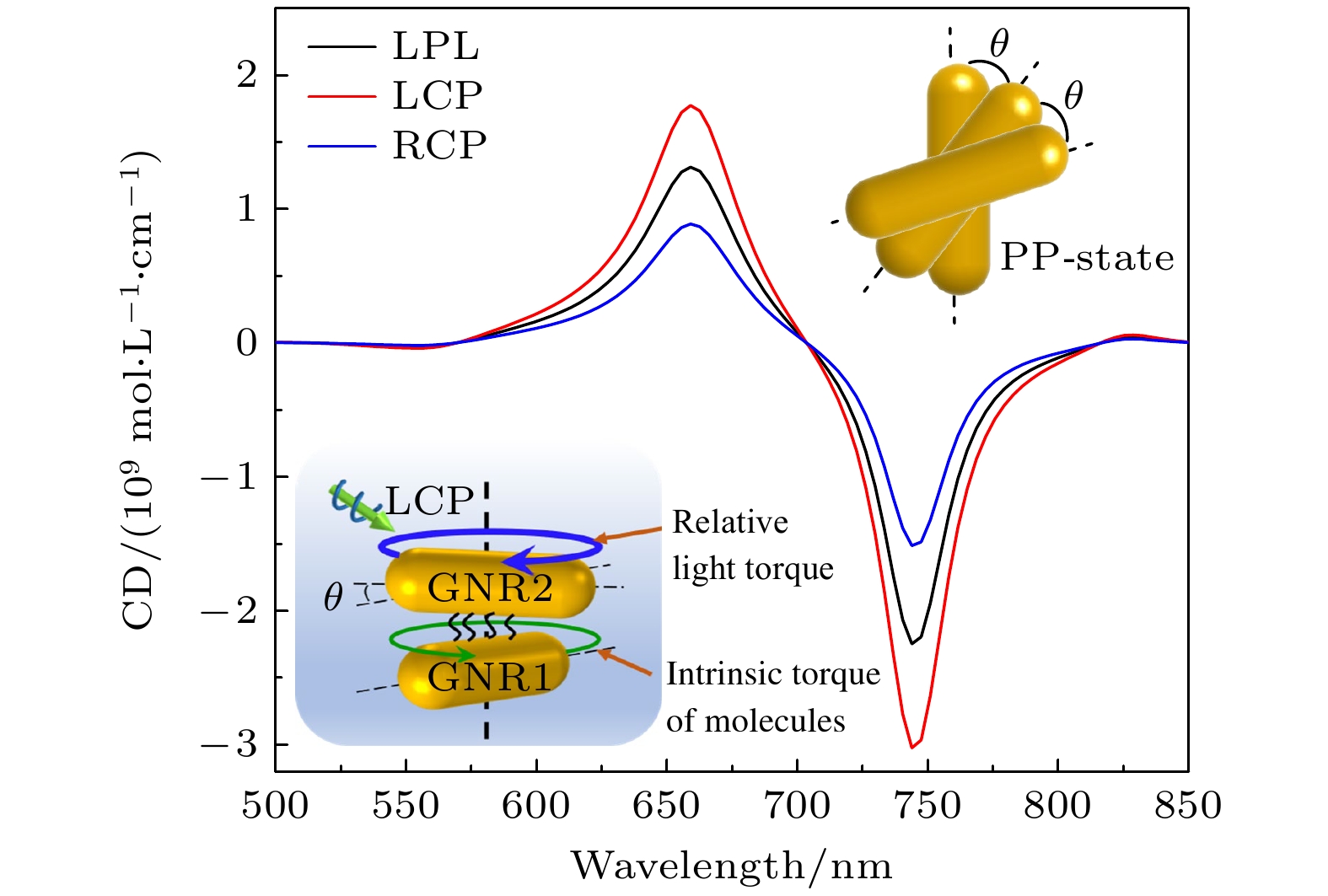


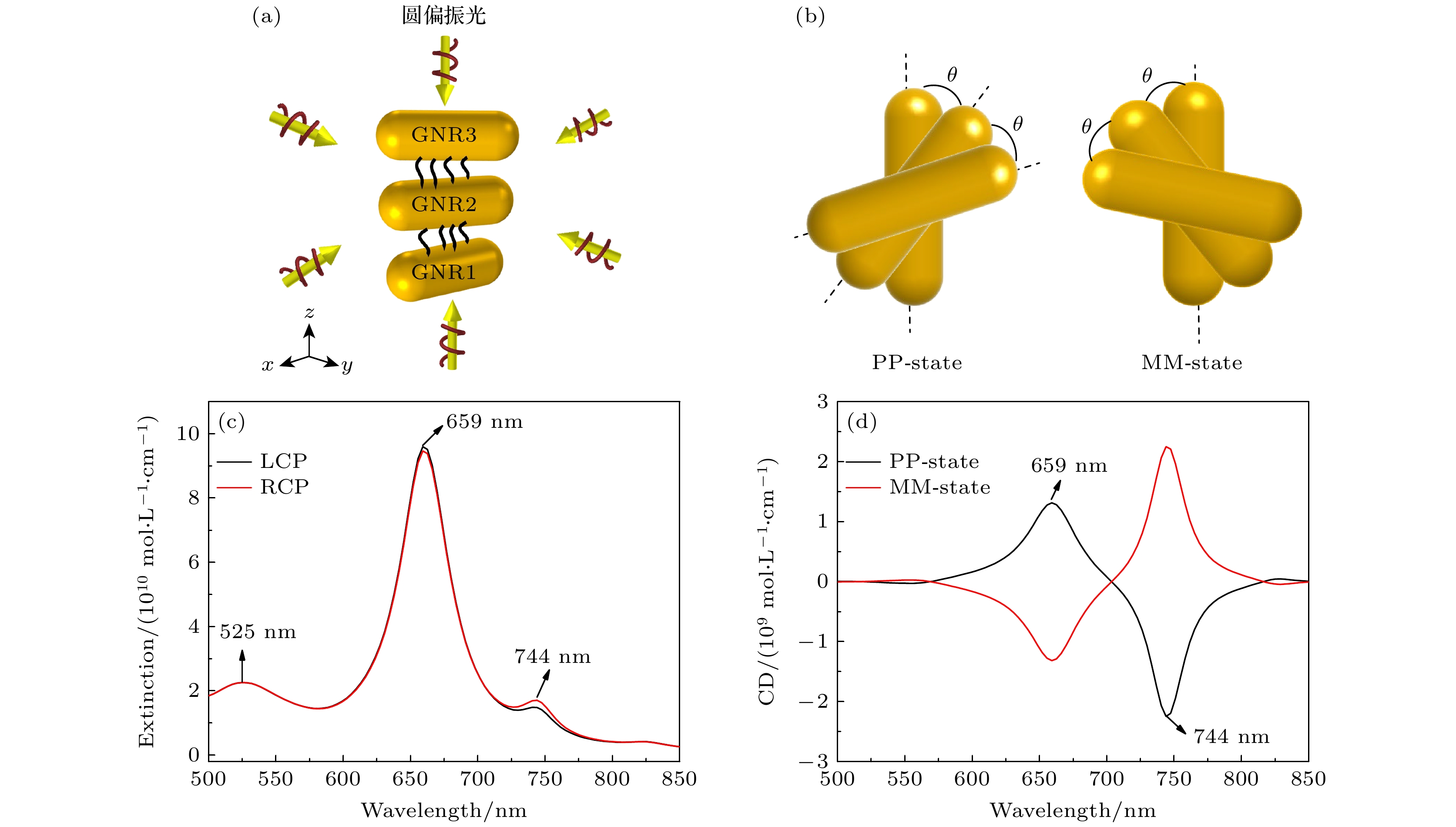
 下载:
下载:

